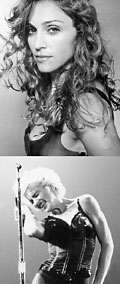VIDEO KILLED the radio star, but it gave birth to Madonna. It also continues to nurture her: The pop star recently merited three slots in MTV’s “Top 100 Greatest Videos Ever Made” (“Vogue” placed second, “Express Yourself” 10th, and “Lucky Star” 50th). Without MTV, pop culture monuments Desperately Seeking Susan, The Immaculate Collection, Truth or Dare, and Sex wouldn’t exist. Instead of reigning as the pop queen who’s up for two Grammies (again!) this year (with “Beautiful Stranger,” from the Austin Powers 2 soundtrack), Ms. Ciccone may have become an ordinary middle-aged woman reminiscing about her days at Danceteria.
Madonna: Video Collection 1993-99 insists that history proved otherwise. A mediocre package that arrives at the end of the era of MTV as music television, the collection’s merit lies more in its images of Madonna than in any pretension to art. With the exception of such jewels as “Fever,” “Bedtime Story,” and “Ray of Light” (who knows why she left out “Erotica” and “Deeper and Deeper”?), most of the videos come off as unremarkable in retrospect. The same holds true for much of her music, as Madonna’s voice works best when remixed—as in Shep Pettibone and Madonna’s early ’90s collaborations, and in William Orbit’s reworking of “Ray of Light.” Forget “La Isla Bonita” or “Papa Don’t Preach”—Madonna’s voice belongs in a nightclub, where it’s more supplemental than serious.
Madonna
Madonna: Video Collection 1993-99 (Warner Bros.)
Her image, however, belongs center stage. Madonna passed up compiling a 1993-99 album, choosing instead to reissue the videos. My friend and I watched the Collection on a DVD player, so we had the good fortune of being able to skip from frame to frame without having to listen to the songs in their entirety. The surreal “Bedtime Story” mesmerized us, but we couldn’t bother watching the dud “Love Don’t Live Here Anymore.” After Madonna transformed from the blue-eyed waif of “Rain” to the Evita-esque diva of “Take a Bow,” I asked my friend, “What do you think Madonna looks like in real life?” With a shrug, he said that he liked the sandy-haired, groovy guru from “Ray of Light” the most, while my own favorite was the platinum blonde, heavily mascaraed fox from “Secret.” We could have been little girls discussing our favorite Madonna Barbie dolls as we compared the dominatrix Madonna of “Human Nature” with the breakdancing geisha version of “Nothing Really Matters.”
My friend questioned why Madonna had to touch herself in every video. Indeed, Ms. Ciccone couldn’t keep those fingers from flirting with her breasts or thighs for very long (this is the woman who refused to omit simulated masturbation on her concert tour). It’s obvious that she doesn’t want us noting the Spanish guitar or studying the wave crashing across the TV screen, as her body language screams for attention. Yet I’d argue Madonna’s more about objectification than exhibitionism—she shows more symbol than self. But before you can slap any genre title or feminist critique on her, she’ll change from material girl to enlightened mystic to the go-go girl of “Beautiful Stranger,” reminding us that she, like the shapeshifter in “Frozen,” controls her own objectification. She doesn’t ask much of us: Don’t listen too hard. Don’t overanalyze her current guise. Just watch. And hopefully, if we watch long enough, one day the array of objects will reveal a subject.








